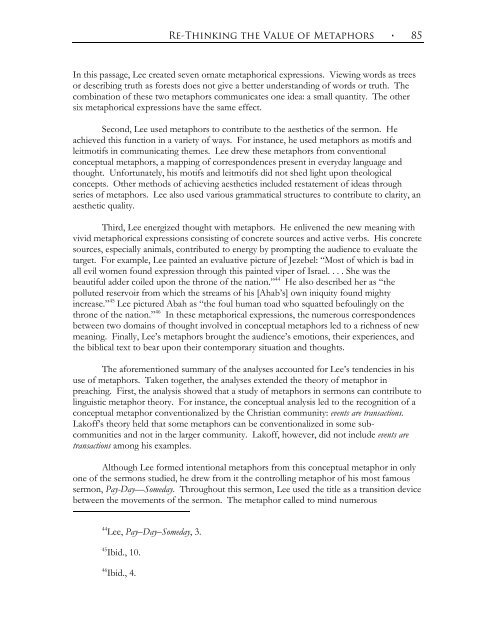0 jbtm vol. 6, no. 2 the proclamation of the gospel - Baptist Center for ...
0 jbtm vol. 6, no. 2 the proclamation of the gospel - Baptist Center for ...
0 jbtm vol. 6, no. 2 the proclamation of the gospel - Baptist Center for ...
Create successful ePaper yourself
Turn your PDF publications into a flip-book with our unique Google optimized e-Paper software.
Re-Thinking <strong>the</strong> Value <strong>of</strong> Metaphors ٠ 85<br />
In this passage, Lee created seven ornate metaphorical expressions. Viewing words as trees<br />
or describing truth as <strong>for</strong>ests does <strong>no</strong>t give a better understanding <strong>of</strong> words or truth. The<br />
combination <strong>of</strong> <strong>the</strong>se two metaphors communicates one idea: a small quantity. The o<strong>the</strong>r<br />
six metaphorical expressions have <strong>the</strong> same effect.<br />
Second, Lee used metaphors to contribute to <strong>the</strong> aes<strong>the</strong>tics <strong>of</strong> <strong>the</strong> sermon. He<br />
achieved this function in a variety <strong>of</strong> ways. For instance, he used metaphors as motifs and<br />
leitmotifs in communicating <strong>the</strong>mes. Lee drew <strong>the</strong>se metaphors from conventional<br />
conceptual metaphors, a mapping <strong>of</strong> correspondences present in everyday language and<br />
thought. Un<strong>for</strong>tunately, his motifs and leitmotifs did <strong>no</strong>t shed light upon <strong>the</strong>ological<br />
concepts. O<strong>the</strong>r methods <strong>of</strong> achieving aes<strong>the</strong>tics included restatement <strong>of</strong> ideas through<br />
series <strong>of</strong> metaphors. Lee also used various grammatical structures to contribute to clarity, an<br />
aes<strong>the</strong>tic quality.<br />
Third, Lee energized thought with metaphors. He enlivened <strong>the</strong> new meaning with<br />
vivid metaphorical expressions consisting <strong>of</strong> concrete sources and active verbs. His concrete<br />
sources, especially animals, contributed to energy by prompting <strong>the</strong> audience to evaluate <strong>the</strong><br />
target. For example, Lee painted an evaluative picture <strong>of</strong> Jezebel: “Most <strong>of</strong> which is bad in<br />
all evil women found expression through this painted viper <strong>of</strong> Israel. . . . She was <strong>the</strong><br />
beautiful adder coiled upon <strong>the</strong> throne <strong>of</strong> <strong>the</strong> nation.” 44 He also described her as “<strong>the</strong><br />
polluted reservoir from which <strong>the</strong> streams <strong>of</strong> his [Ahab’s] own iniquity found mighty<br />
increase.” 45 Lee pictured Abah as “<strong>the</strong> foul human toad who squatted befoulingly on <strong>the</strong><br />
throne <strong>of</strong> <strong>the</strong> nation.” 46 In <strong>the</strong>se metaphorical expressions, <strong>the</strong> numerous correspondences<br />
between two domains <strong>of</strong> thought in<strong>vol</strong>ved in conceptual metaphors led to a richness <strong>of</strong> new<br />
meaning. Finally, Lee’s metaphors brought <strong>the</strong> audience’s emotions, <strong>the</strong>ir experiences, and<br />
<strong>the</strong> biblical text to bear upon <strong>the</strong>ir contemporary situation and thoughts.<br />
The a<strong>for</strong>ementioned summary <strong>of</strong> <strong>the</strong> analyses accounted <strong>for</strong> Lee’s tendencies in his<br />
use <strong>of</strong> metaphors. Taken toge<strong>the</strong>r, <strong>the</strong> analyses extended <strong>the</strong> <strong>the</strong>ory <strong>of</strong> metaphor in<br />
preaching. First, <strong>the</strong> analysis showed that a study <strong>of</strong> metaphors in sermons can contribute to<br />
linguistic metaphor <strong>the</strong>ory. For instance, <strong>the</strong> conceptual analysis led to <strong>the</strong> recognition <strong>of</strong> a<br />
conceptual metaphor conventionalized by <strong>the</strong> Christian community: events are transactions.<br />
Lak<strong>of</strong>f’s <strong>the</strong>ory held that some metaphors can be conventionalized in some subcommunities<br />
and <strong>no</strong>t in <strong>the</strong> larger community. Lak<strong>of</strong>f, however, did <strong>no</strong>t include events are<br />
transactions among his examples.<br />
Although Lee <strong>for</strong>med intentional metaphors from this conceptual metaphor in only<br />
one <strong>of</strong> <strong>the</strong> sermons studied, he drew from it <strong>the</strong> controlling metaphor <strong>of</strong> his most famous<br />
sermon, Pay-Day—Someday. Throughout this sermon, Lee used <strong>the</strong> title as a transition device<br />
between <strong>the</strong> movements <strong>of</strong> <strong>the</strong> sermon. The metaphor called to mind numerous<br />
44 Lee, Pay–Day–Someday, 3.<br />
45 Ibid., 10.<br />
46 Ibid., 4.


